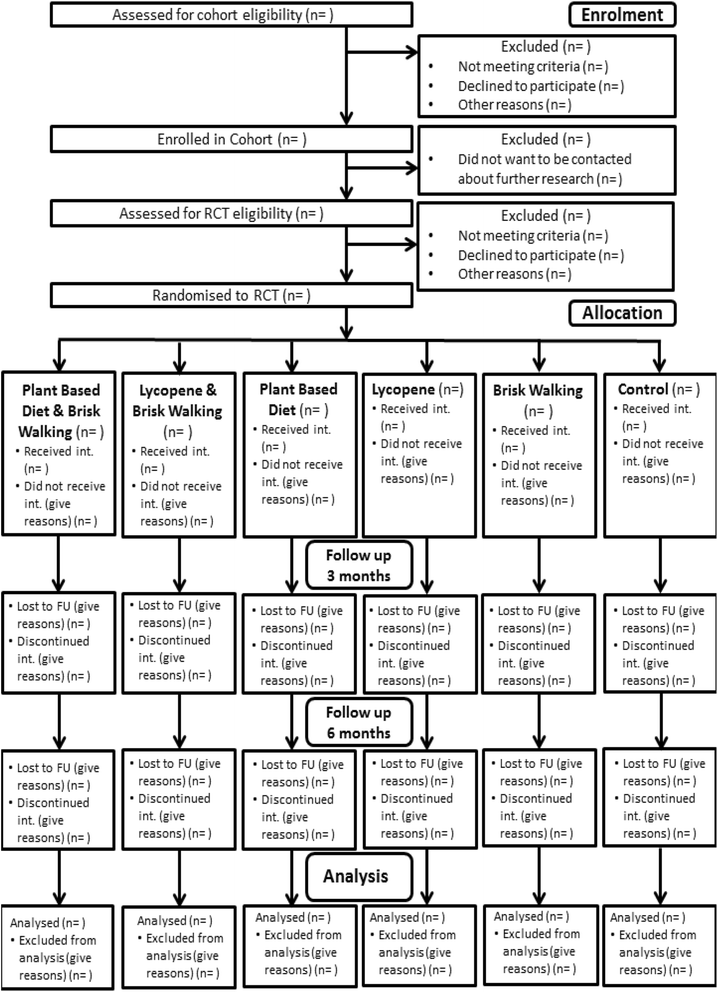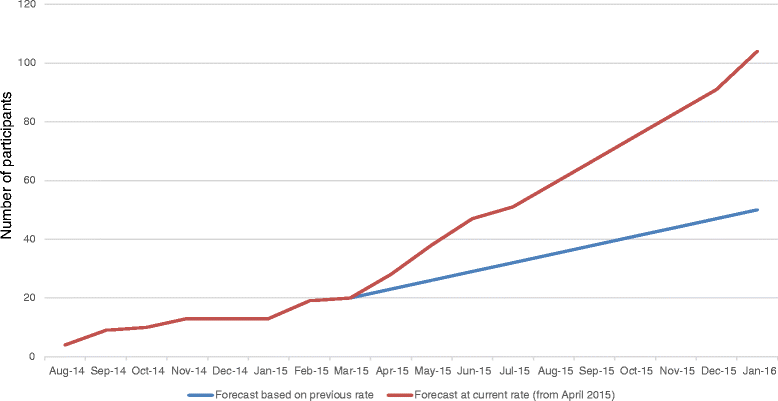Prostate cancer - evidence of exercise and nutrition trial (PrEvENT): study protocol for a randomised controlled feasibility trial
- PMID: 26948468
- PMCID: PMC4780152
- DOI: 10.1186/s13063-016-1248-x
Prostate cancer - evidence of exercise and nutrition trial (PrEvENT): study protocol for a randomised controlled feasibility trial
Abstract
Background: A growing body of observational evidence suggests that nutritional and physical activity interventions are associated with beneficial outcomes for men with prostate cancer, including brisk walking, lycopene intake, increased fruit and vegetable intake and reduced dairy consumption. However, randomised controlled trial data are limited. The 'Prostate Cancer: Evidence of Exercise and Nutrition Trial' investigates the feasibility of recruiting and randomising men diagnosed with localised prostate cancer and eligible for radical prostatectomy to interventions that modify nutrition and physical activity. The primary outcomes are randomisation rates and adherence to the interventions at 6 months following randomisation. The secondary outcomes are intervention tolerability, trial retention, change in prostate specific antigen level, change in diet, change in general physical activity levels, insulin-like growth factor levels, and a range of related outcomes, including quality of life measures.
Methods/design: The trial is factorial, randomising men to both a physical activity (brisk walking or control) and nutritional (lycopene supplementation or increased fruit and vegetables with reduced dairy consumption or control) intervention. The trial has two phases: men are enrolled into a cohort study prior to radical prostatectomy, and then consented after radical prostatectomy into a randomised controlled trial. Data are collected at four time points (cohort baseline, true trial baseline and 3 and 6 months post-randomisation).
Discussion: The Prostate Cancer: Evidence of Exercise and Nutrition Trial aims to determine whether men with localised prostate cancer who are scheduled for radical prostatectomy can be recruited into a cohort and subsequently randomised to a 6-month nutrition and physical activity intervention trial. If successful, this feasibility trial will inform a larger trial to investigate whether this population will gain clinical benefit from long-term nutritional and physical activity interventions post-surgery. Prostate Cancer: Evidence of Exercise and Nutrition Trial (PrEvENT) is registered on the ISRCTN registry, ref number ISRCTN99048944. Date of registration 17 November 2014.
Figures
Similar articles
-
Phase II randomised control feasibility trial of a nutrition and physical activity intervention after radical prostatectomy for prostate cancer.BMJ Open. 2019 Nov 6;9(11):e029480. doi: 10.1136/bmjopen-2019-029480. BMJ Open. 2019. PMID: 31699723 Free PMC article. Clinical Trial.
-
Prostate cancer-Exercise and Metformin Trial (Pre-EMpT): study protocol for a feasibility factorial randomized controlled trial in men with localised or locally advanced prostate cancer.Pilot Feasibility Stud. 2022 Aug 12;8(1):179. doi: 10.1186/s40814-022-01136-7. Pilot Feasibility Stud. 2022. PMID: 35962445 Free PMC article.
-
The feasibility of the Prostate cancer: Evidence of Exercise and Nutrition Trial (PrEvENT) dietary and physical activity modifications: a qualitative study.Trials. 2017 Mar 7;18(1):106. doi: 10.1186/s13063-017-1828-4. Trials. 2017. PMID: 28264695 Free PMC article. Clinical Trial.
-
Nutrition, physical activity, and lifestyle factors in prostate cancer prevention.Curr Opin Urol. 2018 Jan;28(1):55-61. doi: 10.1097/MOU.0000000000000460. Curr Opin Urol. 2018. PMID: 29049045 Review.
-
Management of localised prostate cancer: watchful waiting, surgery or radiation therapy, depending on the natural course, which is often relatively slow.Prescrire Int. 2012 Oct;21(131):242-8. Prescrire Int. 2012. PMID: 23185849 Review.
Cited by
-
Effectiveness of the perioperative encounter in promoting regular exercise and physical activity: a systematic review and meta-analysis.EClinicalMedicine. 2023 Feb 8;57:101806. doi: 10.1016/j.eclinm.2022.101806. eCollection 2023 Mar. EClinicalMedicine. 2023. PMID: 36816345 Free PMC article.
-
Phase II randomised control feasibility trial of a nutrition and physical activity intervention after radical prostatectomy for prostate cancer.BMJ Open. 2019 Nov 6;9(11):e029480. doi: 10.1136/bmjopen-2019-029480. BMJ Open. 2019. PMID: 31699723 Free PMC article. Clinical Trial.
-
Prostate cancer survivors' preferences on the delivery of diet and lifestyle advice: a pilot best-worst discrete choice experiment.Pilot Feasibility Stud. 2020 Jan 6;6:2. doi: 10.1186/s40814-019-0549-8. eCollection 2020. Pilot Feasibility Stud. 2020. PMID: 31921435 Free PMC article.
-
A role for androgen receptor variant 7 in sensitivity to therapy: Involvement of IGFBP-2 and FOXA1.Transl Oncol. 2023 Aug;34:101698. doi: 10.1016/j.tranon.2023.101698. Epub 2023 Jun 10. Transl Oncol. 2023. PMID: 37307644 Free PMC article.
-
Diet and lifestyle considerations for patients with prostate cancer.Urol Oncol. 2020 Mar;38(3):105-117. doi: 10.1016/j.urolonc.2019.06.018. Epub 2019 Jul 18. Urol Oncol. 2020. PMID: 31327752 Free PMC article. Review.
References
-
- Cancer Research UK. Prostate Cancer Key Facts. 2013.
Publication types
MeSH terms
Substances
Associated data
LinkOut - more resources
Full Text Sources
Other Literature Sources
Medical



